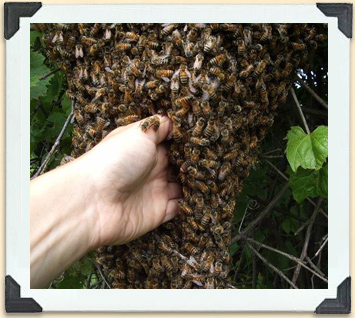The Keeper

Once bees have swarmed, they are more concerned about protecting their queen and finding a new home than stinging someone.
© Ontario Beekeepers' Association, Technology Transfer Program
Swarm Retrieval
If a colony does swarm, the beekeeper still has a chance to get it back. The colony usually lands within 200 metres from the hive it's left. From there, some worker bees leave the cluster to scout for a new home.
If the beekeeper locates the cluster before the bees have found a permanent home and it's in a safe area in which to work (such as a low tree branch), then he or she can probably retrieve the bees. Bees in a swarm are usually quite calm and easy to work with. The beekeeper can either shake the bees into a box, or cut the branch and place the bees (branch and all) into a box to bring them back to a new home. If the beekeeper places a bedsheet, or anything else that creates a walkway for the bees, in front of the new hive, then the bees should walk into it. The bees from the swarm will then form a new colony.




